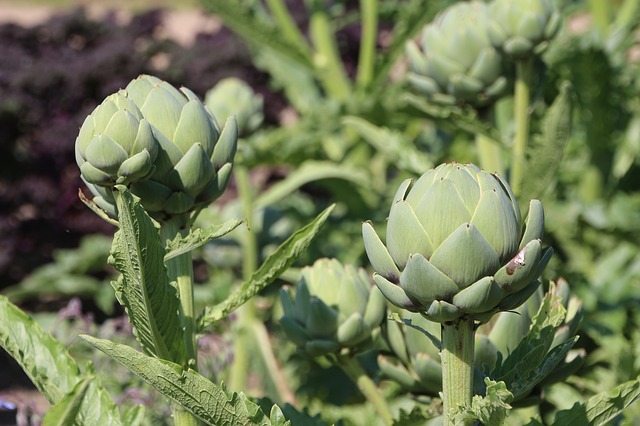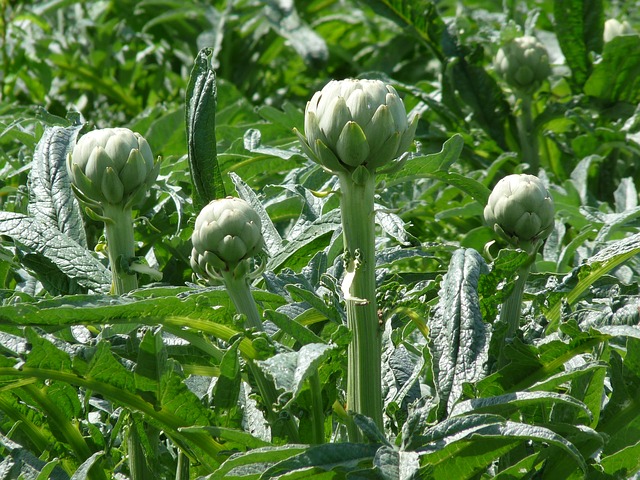Separating Artichokes

Gardening Question from Steve:
I was watching your segment on artichokes and what know one says is ……when you separate the plant from its two or three main plants, do you keep the old original and just remove the new ones, or what? thanks for your help.
Answer from Pat:
You keep the new leaves (suckers) springing from the ground and throw away the old woody stalks that have born fruit. They will not bear again. One way to go is to leave the roots in the ground during winter. If you live in a Mediterranean climate the roots will stay alive in winter. If you have plenty of room this is fine and you can largely neglect them in winter. In spring choose the five largest suckers, one in the center and four evenly spaced around it. Pull off all others, compost them or give them to friends. In March begin feeding and making sure the plant has adequate water. Continually remove suckers, fertilize and water and protect from earwigs, slugs and snails.
Another way to go is to let the plant totally die and next March plant another artichoke beginning with a seed-grown transplant in a 4-inch pot purchased at your nursery. If you feed it and water it plenty and do all I have said to do above you will have a plentiful harvest in June.



I watched your video on growing and dividing globe artichokes- very helpful! Something missing from all the resources I’ve looked at is when the best time to do the dividing is. It looks like in the video it was late summer or early fall. Is that ideal?
I was demonstrating how to treat an artichoke after the end of the season. This is process was to get rid of the old woody center of the plant after harvest and leave one sucker to bear another year. This was July after June harvest. Here below is the schedule:
You did not mention where you live, but artichokes are a perennial plant well adapted to mild coastal Mediterranean climates and generally classed as a cool-season crop. Here in Southern California I call them a “swing season” crop—others are Sugar Snap peas, strawberries, and onions—since we plant them in fall and harvest in spring or early summer. One you can plant artichokes in fall, winter, or early spring but they do not bear a crop until June. My recommendation in Southern California is to conserve water. Thus don’t plant until March 1 when planting your summer veggies, and be sure to plant a seed-grown variety you can find in your local nursery a 4-inch pot and don’t plant from bare root.
Plant in deep fertile soil. Artichokes have massive roots and need a space four to five-feet square in which to grow. Hate to tell you this but to grow really good ones they need a whole lot of water and a great deal of fertilizer. You cannot grow professional looking artichokes without massive amounts of water, which you might not feel worthwhile in a time of drought. If you fertilize adequately and water daily your plant will grow like mad and get a very big in a short amount of time with many suckers. At this point keep pulling off or cutting off the suckers, leaving only four. You can give the suckers to friends if you want. Just stick them in the ground if you want more artichokes and they will grow.
You want to leave one big central stalk, which is what you planted on March One, and four suckers surrounding it like north, south, east, west. Continue throughout spring feeding, watering, and removing the suckers. Also protect from slugs, snails and earwigs. In late May or early June you will see the buds form. If you have done all I have described, on your central stalk you will get one huge artichoke bud in the center and four very nice ones surrounding that. The four suckers you have let mature will bear one medium sized artichoke on top and at least 25 small artichokes (total) some of which you can cook and eat whole. After you have harvested then you can do what I showed on screen, pulling out the 5 central woody stalks that have born fruit and throwing them away. The video I showed was in the garden of one of my daughters and the artichoke didn’t have 5 stalks like mine do, but only one. If it were my garden I would get rid of the whole thing at that point and plant something else. In March I would begin again. Why feed and water a plant all year that doesn’t bear until June, plus why use up all that space in a home garden, when you can begin in March and get the best-ever results? I made the video since I have seen too many gardens with old woody artichoke plants in them. If one wants to keep the lovely foliage, get rid of the old woody central stalks and begin again with a fresh sucker. And the time to do this is late June or early July after harvest.
Hello Pat,
Having problem for right fertilizers,
No sea bird guano in the nursery,
Is there one with numbers for artichokes,
Thanks,
Mira
Any good-quality organic fertilizer recommended for vegetables is fine for artichokes, simply increase the quantity compared with other crops.